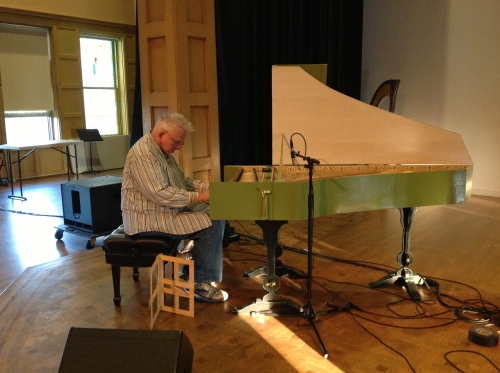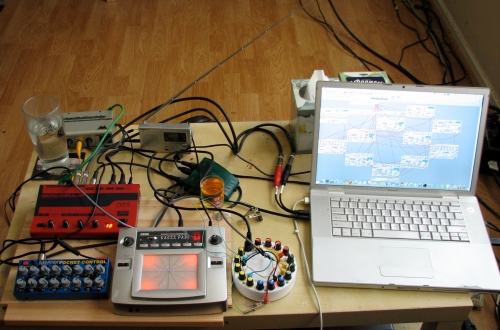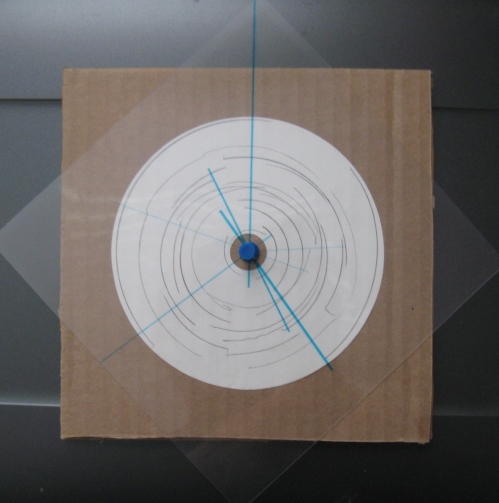This weekend was the third iteration of the yearly Substrata Festival of which I attended the final night. The festival has always been held at the Chapel Performance Space in conjunction with Wayward Music and being on their mailing list I’ve been aware of it from it’s conception but this was my first time attending. Every year there has been one or two acts I’d have been interested in seeing, but being a festival that would of course mean sitting through the rest, some of which were distinctly not to my taste. These festivals are put on by the ambient musician Rafael Anton Irisarri and have proven to be popular enough that they sell out fairly quickly which considering the space is certain to lead to a hot crowded experience. This years festival, which has been expanded to three days, was no exception except that the third day wasn’t sold out when last I got a mailing from Wayward Music and Kim Cascone was closing the festival. I haven’t really kept up with Cascone’s work, but back in the early days of my interest in various experimental forms he had a number of releases I was pretty into. I also have been aware that his recent work is more along the lines of acoustic experiments utilizing beating patterns and acoustical phenomenon which is certainly something I find fascinating if not a primary interest of mine. Since I could secure a ticket online and the other performers on this night, neither of whom I’d heard of, sounded at least interesting I went for it.
Of course the other thing worth mentioning is that this festival is basically ambient music and while I’m not adverse to the form, there really are few outstanding examples of it. The festival is driven by Irisarri’s tastes and has grown to include post-minimalsim as well as an eclectic mix of electronica and hybrid compositions. The materials provided by the festival read rather like an ‘artists statement’ (with all the connotations that implies):
Our goal is to create an immersive weekend experience that engages the audience in a dialog with the artists that goes beyond the constrains of traditional performer/listener interactions. Each showcase is curated to distinctly portrait different takes of the potency of minimalism, varying between weighty combinations of tonalities used to sculpt out atmospheric ambiance, or powerful dynamic structures made up of the subtlest filigree of sonic building materials. By creating compositional spaces dealing with a sense of mass, along with openness of structure, the perspective of scale and the listener’s place in relation is shifted to allow for greater a sense of place beyond the environ of the performance in the interplay of the moment and physics of the larger world. In all, Substrata is an event that fosters appreciation for our natural surroundings and creates meaningful interaction between artists/participants while exploring a new locality.
As the name substrata implies, it is about subtle aesthetics that go beneath the surface and into deeper aural territories.
Saturday July 20th was as nice an evening as can only be found in the Pacific NW. A beautiful sunny day with temps in the uppers 70s (F) by the time I arrived at the Chapel the sun was beginning to dip behind the Olympic Mountains. There was a lot of people here and the wait for the doors to open in the lobby was a hot and sweaty, though happily short, experience. Once we were all inside the Chapel itself wasn’t completely packed and it wasn’t oppressive it at all, especially with the cooling air blowing in from all the open windows. I got a seat a few rows back by a pillar that created a gap that allowed for an easy escape if that proved necessary and was relatively centered. I would have liked to have sat by the windows as I think that would have added greatly to the experience but felt that for the Cascone piece I’d want to be inside the surround sound setup. They had very defined times for each act and apart from starting a bit late maintained that schedule fairly closely.
1) Christina Vantzou
Christina Vantzou is a an American multimedia artist/composer who is now based in Brussels. She introduced the string trio and harpist who would be playing the numerous mostly short (unidentified) pieces on this evenings program and then returnign to her laptop kicked things off with a loud, overbearing synth pad. The pieces were almost all constructed of her playing multitrack recordings on her MackBook while the string trio and harpist played along. The tracks she trigged mostly consisted of rather loud pads and washes plus the occasional sustained vocals worked into multitrack choirs. The musicians were pretty good and several of the pieces where they were more dominate I thought were the more engaging. Their playing was usually fairly long sustained, usually unaffected tones. Even the harpist bowed her instrument in the first piece though after that she played mostly rather staccato notes. Vantzou also “conducted” these pieces, sort of “dancing” around doing rather Butch Morris-esque conducting.
Along with this there was also rather cliched video such as a slowed down candle flame and slow pans of a girl in a church and so on. This it appears was done by an unrelated “video artist” and accompanied most of the performance in the festival.
2) Michal Jacaszek
Michal Jacaszek is a Polish “electro-acoustic composer” who for this show at least appeared to be laptop DJ-ing along with a harpsichord (Kelly Weyse) and clarinets (“Crystal” Beth Fleenor). Rather Saule like in his DJ-ing though with perhaps not quite as good of choices. He used lots of acoustic instrument samples and was perhaps processing and sampling the two live instruments but it did seem that barring improvisation from the instrumentalists (which did not seem to be the case) he could have just played their contributions along with multitude of other elements he was utilizing. Often fairly loud and dense each peice always had a point (or two) were everything dropped out to a bare minimum and then rebuilt in a different direction. Overall fine with some nice moments, typically involving the harpsichord and bass clarinet interacting with the more worn way, fractured less beat-driven samples.
The video that was played along with Jacaszek included lots of slowed down water images and some forests shots but also some bad cg effects and cartoony figures with Afteraffects fliters applied to them.
3) Kim Cascone
In the booklet that accompanied the festical was a good four pages of bio and rumination from Kim Cascone. In it he goes through his history with meditation and developing “heightened awareness” especially w/r/t listening. It even includes a series of exercises for you the listener to go through. I have to say that while I’m sympathetic to his goals here I can’t help but wonder if it is perhaps not better to just let the listener find one’s own way there? It didn’t spoil my enjoyment of the performance, though this, along with his introduction of the piece as “aural meditation”, did add a ponderousness to it that I do not think is inherent to the sounds. Cascone sat in the very middle of the surround sound speaker setup which also included a huge sub-woofer right in the middle of the room. Equipped with just a laptop and mixer he played for about 30 minutes in the dark with no video playing. We were instructed to sit with our eyes closed and focus on our breath which I did. He also told us that since this wasn’t really music there was no need to applaud at the end. The sounds were all beating tones at first pretty intense and then of varying intensities as the sounds shifted. Typically he’d pick a pattern, which all resolved itself in your head into hyper-rythmic oscillations, sometimes with higher pitched stuff seeming to swirl about at an upper level, other times just a single repeated sound. This he’d let play out for a decent amount of time, at least five minutes I’d say – this would be about six different sounds over the thirty minutes which seems about right. There was definitely those interesting physical sensations of vibrating in the ear that you get with these acoustic experiments. I agree with his assessment that it’s not really music per se – that is he was more or less just presenting one acoustical phenomenon after another – but it was fascinating and completely engaging. It just being thirty minutes was also a wise choice; too much might get tedious and this seemed just the right amount to keep one interested and engaged the whole time. Good stuff and while not a very effective aid to meditation IMO (the highly rhythmic nature tends to force you into a pattern that is contrary to natural breathing, which rather undermines the “focus on breath” aspect) it was a good focusing experience. It probably would have been aurally interesting to have been able to walk around during the performance but I certainly respected his setting of the events parameters.





































You must be logged in to post a comment.